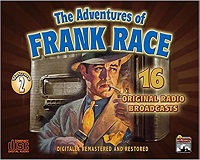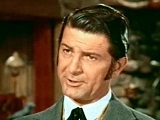“Before the war, Frank Race worked as an attorney,
but he traded his law books for the cloak-and-dagger of the OSS.
When the war was over, his former life was over, too . . .
adventure had become his business!”
The Adventures of Frank Race (1949-50) aired “The Adventure of the Runway Queen” on November 20, 1949, as the 30th of its 43 episodes. Original air dates for this program are impossible to pin down with 100% accuracy due to the fact that it was not sold to one of the four major national radio networks who would air the shows at a set day and time nationwide, but was syndicated to individual stations across the country who would broadcast episodes at whatever dates suited their local programming. This is only the third episode featuring Frank Race’s adventures we have run, the first coming on December 10, 2022 and the second on May 20th of this year, 2023. As such, a recap of the introductory background material provided in that initial episode is below, for newcomers to the show or for those needing to refresh their memories.
The italicized opening at the top of this page is the host’s introduction to each episode. The premise of a private investigator with a government background such as the O.S.S. (Office of Strategic Services, forerunner to our C.I. A.) was not new. Radio had a number of programs prior to Frank Race when espionage was still in the minds of the public following World War II, among them Secret Agent K-7 (1939), The Man Called X (1944), Dangerous Assignment (debuting in 1949), and also debuting in 1949 was Richard Diamond, Private Detective who had a background which included the O.S.S.. The Adventures of Frank Race has been characterized as a combination of Johnny Dollar and James Bond. Johnny Dollar in that Race also investigates (as his cover) for an insurance firm, and James Bond due to the women, intelligent, beautiful and honest (well some of them)—as well as some not so trustworthy, with whom he has encounters. While Race obviously has “cases” due to his work for the insurance company, they are designed more as world-traveling adventures, thus the title of the show.
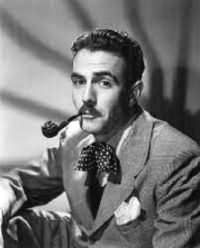 Tom Collins (1913-1973, photo at right) starred as Frank Race for the show’s first 22 episodes. Collins was well known to radio fans as the voice of Chandu in the 1948 run of Chandu the Magician. Beginning with episode 23, Collins would pass the torch to versatile and talented radio actor Paul Dubov (1918-1979, photo top right), and nary a beat was missed. From 1938-1977 Dubov appeared in many film and/or TV shows, a few among them being Day the World Ended (1955), The She Creature (1956), Voodoo Woman (1957), and The Underwater City (1962) for film, and Wanted, Dead or Alive (1960) and Bat Masterson (1961) for TV. Though the title role was split evenly between Collins and
Tom Collins (1913-1973, photo at right) starred as Frank Race for the show’s first 22 episodes. Collins was well known to radio fans as the voice of Chandu in the 1948 run of Chandu the Magician. Beginning with episode 23, Collins would pass the torch to versatile and talented radio actor Paul Dubov (1918-1979, photo top right), and nary a beat was missed. From 1938-1977 Dubov appeared in many film and/or TV shows, a few among them being Day the World Ended (1955), The She Creature (1956), Voodoo Woman (1957), and The Underwater City (1962) for film, and Wanted, Dead or Alive (1960) and Bat Masterson (1961) for TV. Though the title role was split evenly between Collins and 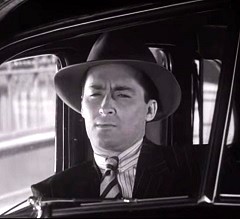 Dubov during the show’s run, Race’s sometimes valet/cab driver/associate and “sidekick” if you will, was Marc Donovan, played perfectly throughout all 43 episodes by Tony Barrett (1916-1974, photo at left as the character Melody Fiske, a piano playing thug in the 1947 film Dick Tracy Meets Gruesome, featuring Boris Karloff), another of radio and TV’s most versatile actors, writers, and even producers. Two of his several TV credits include being one of the writers for the popular detective program Peter Gunn (1958) and one of the primary developers of The Mod Squad (1968). A few of the supporting actors appearing in episodes during the show’s run were many of radio’s finest, including Gerald Mohr, Frank Lovejoy, Lurene Tuttle, Virginia Gregg, and Parley Bear.
Dubov during the show’s run, Race’s sometimes valet/cab driver/associate and “sidekick” if you will, was Marc Donovan, played perfectly throughout all 43 episodes by Tony Barrett (1916-1974, photo at left as the character Melody Fiske, a piano playing thug in the 1947 film Dick Tracy Meets Gruesome, featuring Boris Karloff), another of radio and TV’s most versatile actors, writers, and even producers. Two of his several TV credits include being one of the writers for the popular detective program Peter Gunn (1958) and one of the primary developers of The Mod Squad (1968). A few of the supporting actors appearing in episodes during the show’s run were many of radio’s finest, including Gerald Mohr, Frank Lovejoy, Lurene Tuttle, Virginia Gregg, and Parley Bear.
“The Adventure of the Runway Queen” begins in one of the most unusual venues we can recall, and sets the stage for a most curious mystery, as Frank Race finds himself answering a call for help from a Hollywood talent scout-cum-agent who now resides in an insane asylum. Though Race’s price is well above the common street gumshoe, he knows he will be well paid if he can solve this puzzling case. The Hollywood agent, Barney Lang, needs help finding out where one of his discoveries disappears to when not at her one night a week radio show where she pulls in $5,000 as a popular singer. Lang explains that not long ago the young woman he found in a strip club, Lori Marlowe, had a voice no one else noticed, so he took her in and made her who she is today. But then Lori recently turned down a lucrative Hollywood film contract and wouldn’t give Lang a believable answer for turning down a once in a lifetime opportunity. So when Race discovers that after her lone night on the radio making $5k a week, she spends the rest of her week at a local burlesque he begins stirring the pot with her friends and dance hall boss, trying to piece together the reason or reasons this Lori Marlowe, rich radio singer who prefers to work at a strip club, does what she does. Why would a talented young woman pulling in great dough for a night’s work on the radio, turn down a Hollywood film contract and spend the rest of her time stripping for $75 a week? Race has a feeling he’ll be earning his fee ferreting out the answers, and though the case seems harmless enough, the quite unexpected murder of one of those involved heightens the drama as we learn the whole sordid story behind “The Adventure of the Runway Queen.”
(The linked CD at the top includes this episode and 15 others.)
Play Time: 26:57
{This episode of Frank Race aired on a Sunday evening less than a week before Thanksgiving in 1949. The next day after school the neighborhood gang was still in the mood for some mystery spiced with a little danger and so found themselves at the corner newsstand perusing any new selections they had missed on their previous visit. Detective Tales (1935-53) ran for 18 years and over 200 issues, so the publisher must have found the sweet spot for which detective and/or murder mystery tales his audience loved. It was a monthly for almost all of its run, foregoing that schedule only for the final three years of its life. Super-Detective (1934-35, 1940-50) began it first incarnation only 3 years after the advent of the “Spicy” pulps, but despite its relatively “lurid” covers the stories failed to excite and it folded after only 15 issues. It reinvented itself in 1940 as a pulp character-focused magazine featuring Jim Anthony, businessman, scientist, and adventurer. From 1940 through late 1943 Anthony’s adventures were featured in every issue. The magazine never had what could be called a regular schedule, some years seeing only 2 or 3 issues, while others might sport 8 or 9. 1949 saw 4 issues, 2 quarterly in the first half of the year and two bi-monthly issues at the end of the year. Super Science Stories (1940-43, 1949-51) appeared to have some problems, folding during WWII and then starting again a few years after the war when the economy had recouped. Though not lasting very long in either incarnation it nevertheless attracted major talent, among other authors finding their stories welcome within its pages were Ray Bradbury, Poul Anderson, Henry Kuttner, Murray Leinster, Fredric Brown, L. Sprague de Camp, Jack Williamson, and Leigh Brackett. It managed 5 issues in 1949 as it transitioned from a bi-monthly to a quarterly schedule.}
[Left: Detective Tales, 11/49 – Center: Super-Detective, 10/49 – Right: Super Science Stories, 11/49]
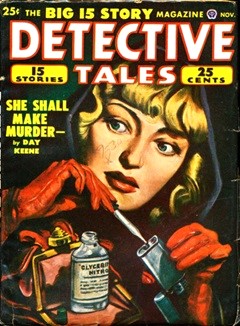
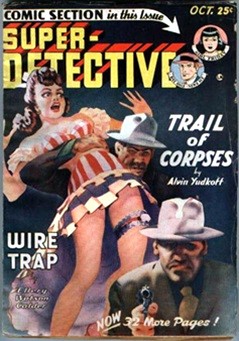
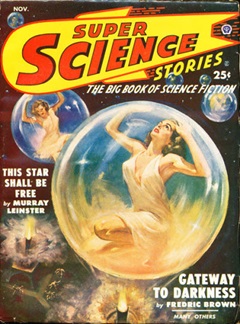
To view the entire list of weekly Old Time Radio episodes at Tangent Online, click here.
